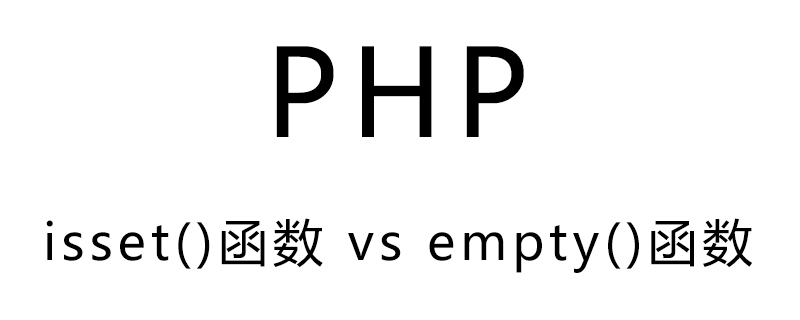
It is easy to confuse between isset() and empty() in PHP. They are both used to test the value of variables and both return a Boolean value. The following article will take you to understand isset() and empty(), I hope it will be helpful to you.

PHP isset() function
isset() function is used to determine whether a variable has been set and is not null; in other words, returns true only if the variable is not null.
Basic sentence structure:
bool isset( mixed var [, mixed var [, ...]] )
Example:
<?php
header("content-type:text/html;charset=utf-8");
function checkIfIsset($value)
{
if(isset($value)) {
return "它被设定";
}else {
return "它没被设定";
}
}
$value = false;
echo checkIfIsset($value);
?>Output:

PHP empty() function
empty() function is used to determine whether a variable is empty; in other words, if the variable is an empty string, false, array(), NULL, "0 ”, 0 and unset variables, it will return true.
Basic sentence pattern:
bool empty(mixed var)
Example:
<?php
header("content-type:text/html;charset=utf-8");
function checkIfnotEmpty($value){
if (!empty($value)) {
return "它不是空的";
} else {
return "它是空的";
}
}
$value = '';
echo checkIfnotEmpty($value);
?>Output:

The difference between isset() and empty() functions in PHP
1. If the isset() function contains flase, 0 or empty string value, it will return true; otherwise it will return false. The empty() function returns true if it contains empty, 0, null or false values; if the string contains non-empty and non-zero values, it returns false.
2. If the value does not exist, the isset() function will return false, and the empty() function will return true.
The following table is a simple reference of what these functions will return for the different values. A space indicates that the function returns bool (false).
| Value of variable ($var) | isset($var) | empty($var) |
|---|---|---|
| ""(empty character String) | Boolean (true) | Boolean (true) |
| “ “ (space character) | Boolean (true) | |
| ##false | ## Boolean (true) | Boolean (true) |
| true | Boolean (true) | |
| Boolean (true) | Boolean (true) | |
|
Boolean (true) |
||
| Boolean (true) | Boolean (true) | |
| Boolean (true) | Boolean (true) | |
| Boolean (true) | Boolean (true) | |
| (Declared variable, but no Value) | ##Boolean (true) |
|
| NUllbyte("\0")Boolean (true) | The above is the entire content of this article, I hope it will be helpful to everyone's study. For more exciting content, you can pay attention to the relevant tutorial columns of the PHP Chinese website! ! ! |
The above is the detailed content of A brief discussion on the difference between isset() and empty() functions in PHP. For more information, please follow other related articles on the PHP Chinese website!